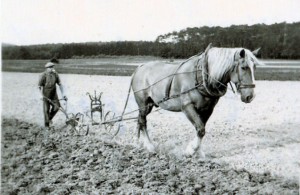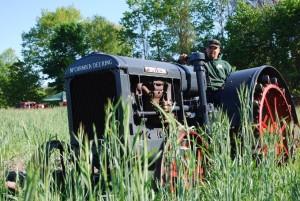They say that “necessity is the mother of invention.” This proved true during World War 1, when a shortage of horses and a demand for farm production propelled the tractor to take its place in American agriculture.
 At the height of World War 1, horses were in high demand – at one point, the average lifespan of a horse on the European front was just 10 days! By 1917, the loss of a horse was more harmful to many units than the loss of a soldier. Great Britain’s own supply of available horses soon wore thin, and the USA supplied a significant number, along with allies in Australia and New Zealand. Millions of horses served in the military forces, and very few ever returned home.
At the height of World War 1, horses were in high demand – at one point, the average lifespan of a horse on the European front was just 10 days! By 1917, the loss of a horse was more harmful to many units than the loss of a soldier. Great Britain’s own supply of available horses soon wore thin, and the USA supplied a significant number, along with allies in Australia and New Zealand. Millions of horses served in the military forces, and very few ever returned home.
Farmers back in America felt the pinch – the government was asking them to increase agricultural production while at the same time asking for more horses! As the supply of available working horses dropped in the USA, the price increased – and the “iron horse” became a viable alternative. (While the term “iron horse” was most commonly used to describe steam locomotives, it was also used for early tractors).
While WWI and the global shortage of horses isn’t ultimately responsible for the adoption of tractors, it certainly sped things along! The military worked hard to develop tractors that could replace horses on the front lines, pulling wagons and artillery. At the same time, farmers began to seriously look into tractors as an alternative source of power.
The Fordson, McCormick-Deering 10-20, and John Deere Waterloo Boy (among many other manufacturers and models) stepped in to fill this need for power on American farms. Production  skyrocketed during the war. In 1914 (the start of WWI) roughly 15,000 tractors were produced. By the war’s end in 1918, more than 130,000 tractors were rolling off the production lines.
skyrocketed during the war. In 1914 (the start of WWI) roughly 15,000 tractors were produced. By the war’s end in 1918, more than 130,000 tractors were rolling off the production lines.
While horses would still retain their vital roles in American agriculture for many more years, WWI was a great leap ahead for tractors.
allen e anderson says
very interesting!!!
Ronald Kearn says
Rachel, are these your own words? Is this your writing? If so you are an excellent writer with a great command of the English language. I also loved the subject matter. I found it fascinating and could not hel it that someone thought about this transition. Great Job Rachel, er usual. “-)